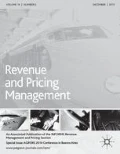Abstract
As revenue management research progresses, simplifying assumptions are removed from the underlying mathematical models. In consequence, these models grow, leading to an increase in complexity that may affect both the performance of automated systems and revenue management analysts. In this article, we demonstrate how both hierarchical and dynamic complexity may increase as revenue management models become more sophisticated. For this purpose, we introduce an example of dynamic complexity based on forecast parameterization based on a simulation study. On the basis of a data analysis created in cooperation with Deutsche Lufthansa, we demonstrate the dependence of state-of-the-art revenue management systems on analyst input. We argue that increased complexity endangers the performance of both analysts and automated systems if it is not deliberately managed. Finally, we discuss five possible strategies for responding to increasing complexity: Ignorance, full automation, visualization, result simulation and input transformation. We describe the possible implementation of each strategy and list the opportunities and challenges that each of these response entails for revenue management.



Similar content being viewed by others
References
Bartke, P., Zimmermann, B. and Cleophas, C. (2011) Complexity management in airline RM. In: Meeting of the Agifors Working Group Revenue Management and Cargo, Taipei.
Becker, B. and Dill, N. (2007) Managing the complexity of air cargo revenue management. Journal of Revenue and Pricing Management 6 (3): 175–187.
Belobaba, P. (1987) Air travel demand and airline seat inventory management. Unpublished Doctoral dissertation, Massachusetts Institute of Technology.
Boyd, E. and Bilegan, I. (2003) Revenue management and e-commerce. Management Science 49 (10): 1363–1386.
Cleophas, C., Frank, M. and Kliewer, N. (2009) Simulation-based key performance indicators for evaluating the quality of airline demand forecasting. Journal of Revenue and Pricing Management 8 (4): 330–342.
Currie, C. and Rowley, I. (2010) Consumer behaviour and sales forecast accuracy: What's going on and how should revenue managers respond? Journal of Revenue & Pricing Management 9 (4): 374–376.
Fitts, P. (ed.) (1951) Human Engineering for an Effective Air-Navigation and Traffic-Control System. Columbus, OH: Ohio State University Research Foundation.
Frank, M., Friedemann, M. and Schröder, A. (2008) Principles for simulations in revenue management. Journal of Revenue & Pricing Management 7 (1): 7–16.
Gilbert, G. (2008) Agent-Based Models. London: Sage Publications.
Isler, K. and Imhof, H. (2008) A game theoretic model for airline revenue management and competitive pricing. Journal of Revenue & Pricing Management 7 (4): 384–396.
Jarvis, P. (2002) Introducing yield management into a new industry. Journal of Revenue & Pricing Management 1 (1): 67–75.
Kracht, J. and Wang, Y. (2010) Examining the tourism distribution channel: Evolution and transformation. International Journal of Contemporary Hospitality Management 22 (5): 736–757.
Littlewood, K. (1972) Forecasting and control of passenger bookings. Proceedings of the 12th AGIFORS Symposium 12: 95–117.
McGill, J. and van Ryzin, G. (1999) Revenue management: Research overview and prospects. Transportation Science 33 (2): 233.
Mitchell, C.M. (1999) Model-based design of human interaction with complex systems. In: A.P. Sage and W.B. Rouse (eds.) Handbook of Systems Engineering and Management. New York: John Wiley.
Mitchell, M. (2009) Complexity: A Guided Tour. New York: Oxford University Press.
Mukhopadhyay, S., Samaddar, S. and Colville, G. (2007) Improving revenue management decision making for airlines by evaluating analyst-adjusted passenger demand forecasts. Decision Sciences 38 (2): 309–327.
Norman, D.A. (1986) Cognitive engineering. In: Norman, D.A. and Draper S.W. (eds.) User Centered System Design, New Perspectives on Human-Computer Interaction. Hillsdale, NJ: Lawrence Earlbaum Associates, pp. 31–61.
PROS Holdings, Inc. (2010) Revenue management solution, http://www.prospricing.com/PROS-Solutions/Revenue-Management-Suite/,year=2011.
Simon, H. (1962) The architecture of complexity. Proceedings of the American Philosophical Society 106 (6): 467–482.
Smith, B., Leimkuhler, J. and Darrow, R. (1992) Yield management at American airlines. Interfaces 22 (1): 8–31.
Spengler, T., Rehkopf, S. and Volling, T. (2007) Revenue management in make-to-order manufacturing – An application to the iron and steel industry. OR Spectrum 29 (1): 157–171.
Talluri, K., Castejon, F., Codina, B. and Magaz, J. (2010) Proving the performance of a new revenue management system. Journal of Revenue and Pricing Management 9 (4): 300–312.
Talluri, K. and van Ryzin, G. (1999) A randomized linear programming method for computing network bid prices. Transportation Science 33 (2): 207–216.
Talluri, K. and van Ryzin, G. (2004) Theory and Practice of Revenue Management. Boston, MA: Kluwer.
Weatherford, L. and Ratliff, R. (2010) Review of revenue management methods with dependent demands. Journal of Revenue & Pricing Management 9 (4): 326–340.
Zhang, D. and Cooper, W. (2005) Revenue management for parallel flights with customer-choice behavior. Operations Research 53 (3): 415–431.
Author information
Authors and Affiliations
Corresponding author
Rights and permissions
About this article
Cite this article
Bartke, P., Cleophas, C. & Zimmermann, B. Complexity in airline revenue management. J Revenue Pricing Manag 12, 36–45 (2013). https://doi.org/10.1057/rpm.2012.26
Received:
Revised:
Published:
Issue Date:
DOI: https://doi.org/10.1057/rpm.2012.26




